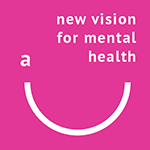
![]() Our vision of mental and emotional health increases the focus on emotions, values the emotional heart of service provision and minimises stigma by celebrating diversity.
Our vision of mental and emotional health increases the focus on emotions, values the emotional heart of service provision and minimises stigma by celebrating diversity.
“… the heart of our work is the hurt in our hearts”
Increasing the focus on emotional health
Emotions, such as grief, anger, fear, despair and shame are the core experiences of most “mental” health problems. This is especially so for people needing help with common life problems, such as bereavement or divorce, or with common mental health problems, such as depression or anxiety.
We also know that the biggest impact on biophysical health stems from lifestyle habits such as smoking, obesity or addiction where there is often an underlying mental and emotional health issue.
“… patients don’t care what you know until they know that you care”
The emotional heart of service provision
The rational-technical approach of science has brought about enormous technological development, and because of this we have assumed that mental health problems can also be solved by this approach. Emotions, however, are by definition not rational and we need to accept that emotional problems require emotion-focused solutions. This is especially true of mental health services which need, first and foremost, to develop emotionally therapeutic relationships with their service users.
We are, at heart, emotional beings who form emotional relationships with other people and with the world in which we live. This is especially relevant to mental health services, which need to focus on the emotional relationship that service users form with the service. Organisations therefore need to reflect on these relationships through, for example, asking emotion-focused questions: 1. What does this service feel like? 2. Do you feel genuinely cared for (while using the service and also afterwards)? Some questions to ask about the service itself: 1. What could we – as service providers – do to make this service feel: 2. How can we work with our staff to ensure that they genuinely care for the people who use our services? How can we support them when caring becomes more difficult?
 Minimising stigma by celebrating diversity
Minimising stigma by celebrating diversity
Stigmatisation is still a common reaction to mental health problems, which remain surrounded by prejudice, ignorance and fear. This causes a great deal of emotional distress for service users. The current disease model of mental ill-health is founded on the idea that people should fit into a standard for what is normal – with diagnostic labels describing the faulty and defective. In reality, however, most people who experience “abnormal” symptoms live “normal” lives – research has concluded, for example, that up to 28% of the general population hear voices that other people do not, but only a few people find these voices problematic.1 Also see “Developing services that don’t rely on an increasingly complex system of diagnostic labelling” (“A coherent system” theme page).
1 “Hearing voices is an auditory hallucination that may or may not be associated with a mental health problem. It is the most common type of hallucination in people with psychotic disorders such as schizophrenia. However, a large number of otherwise healthy individuals have also reported hearing voices.” See here.
Most recent posts about emotion-focused care
- Abuse is main driver of mental ill health in women and girls, say psychiatrists
- Bad Feelings, Best Explanations: In Defence of the Propitiousness Theory of the Low Mood System
- How Animals Help Us Heal with Dr. Joanne Cacciatore
- The History of Emotions: A Very Short Introduction
- Turning Emotion Inside Out: Affective Life Beyond the Subject (Studies in Phenomenology and Existential Philosophy)
- Meeting Mental Breakdown Mindfully
- The Dictionary of Obscure Sorrows
- Adverse Childhood Relationship Experiences: The Most Underestimated Risk Factor for Chronic Illness
- Exploring novel approaches to youth mental health
- The ERNI Declaration: Making Sense of Distress Without “Disease”
